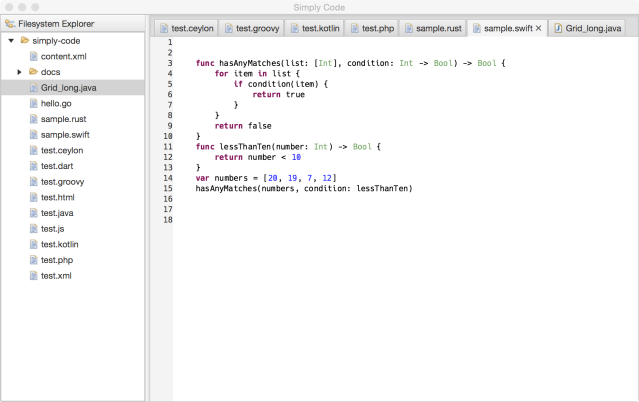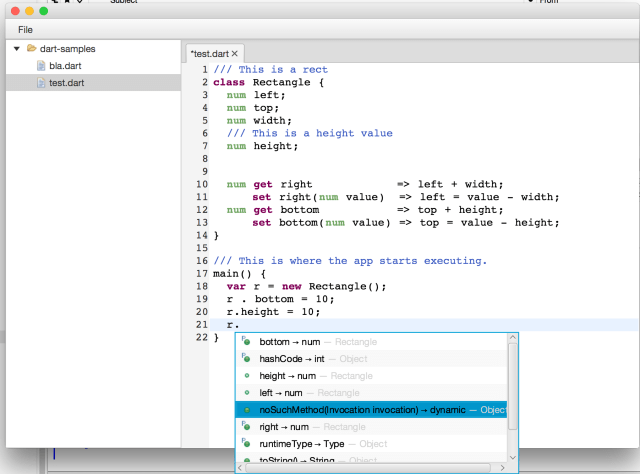I’m happy to announce that e(fx)clipse 2.1.0 has been released today and it has a heap of new features and bugfixes (in total 49 tickets have been resolved).
The project
Starting with this release I’d like to publicly document the amount of time we spend on the project. For this 2.1.0 we spend ~150 work hours and another ~60 private hours. So if you appreciate all this we certainly welcome all donations.
In the next release cycle we’ll also setup bug bounties for often requested features like Min/Max support or detach through DnD. In case you miss something don’t be shy get in touch with us.
Where do you get it
- Tooling:
- p2-Repository – http://download.eclipse.org/efxclipse/updates-released/2.1.0/site
- All-In-One Build – http://efxclipse.bestsolution.at/install.html
- Runtime:
- p2 repository – http://download.eclipse.org/efxclipse/runtime-released/2.1.0/site and http://download.eclipse.org/efxclipse/runtime-released/2.1.0/site_assembly.zip
- R5 repository (eg for usage with bnd/bndtools) – http://download.eclipse.org/efxclipse/runtime-released/2.1.0/bindex-repository.zip
- maven central (only parts of the runtime) under the group-id
at.bestsolution.eclipse
- Eclipse Platform
- com.ibm.icu.base
- org.eclipse.e4.core.di.annotations
- org.eclipse.equinox.common
- org.eclipse.jdt.annotation
- e(fx)clipse
- org.eclipse.text
- org.eclipse.fx.core
- org.eclipse.fx.ui.panes
- org.eclipse.fx.ui.animation
- org.eclipse.fx.ui.controls
- org.eclipse.fx.core.di
- org.eclipse.fx.text
- org.eclipse.fx.text.ui
- org.eclipse.fx.code.editor
- org.eclipse.fx.code.editor.fx
- go
- dart
- groovy
- java
- js
- kotlin
- php
- python
- rust
- swift
- xml
- Defining source editors with a DSL
- Developing a source code editor in JavaFX (without e4 and OSGi)
- Developing a source code editor in JavaFX (on the Eclipse 4 Application Platform)
- Access Dart Analysis Server from Java
Core libraries published on maven central
As many of our components don’t require to run in an OSGi-Environment and can be used in any application we started to publish them on maven-central.
Smart Code editing
If you follow this blog regularly it should not be a surprise that one of the main working areas has been to extract components from our research projects and make them available as loosely coupled components allowing one to implement code editors in a very simple way (nothing is bound to OSGi and e4!).
We ship lexical highlighters you can use in your own applications for the following languages by default:
In case you are interested in using the APIs there’s a series of blogs who introduce the APIs and the tooling who makes it very easy for you to develop an editor for your favorite language or DSL:
and more blogs on this topic will follow soon. Finally it is important to understand that all the code editing APIs are declared as provisional because we need to get feedback from adopters and maybe adjust them here and there.
New APIs
There’s a bunch of new APIs available and I won’t describe all of them but the most interesting are:
@Preference / Value
While there’s a preference annotation in the e4 platform we ship our own one because the current implementation available from the platform is not working the way we expect you to develop components (hint: we expect you to write components without any dependency on OSGi and eclipse platform APIs).
Usage is straight forward:
import org.eclipse.fx.core.preferences.Preference;
import org.eclipse.fx.core.preferences.Value;
class MyComponent {
@Inject
@Preference(key="myStringPrefValue")
Value<String> sValue;
@Inject
@Preference(key="myIntegerPrefValue")
Value<Integer> iValue;
}
And because the the annotation can make use of the adapter services who are part of the core platform you can exchange Value through javafx.beans.property.Property<T>. Read more at the wiki.
EventBus
A similar problem you face with publishing preferences or context values is to publish informations on the IEventBroker who has a compile time dependency on the OSGi-Event-Interface.
Starting with 2.1.0 we provide our own simple EventBus-API you can use instead of the IEventBroker when publishing events. In an e4 application we simply wrap the IEventBroker and none OSGi users we provide a default implementation org.eclipse.fx.core.event.SimpleEventBus.
Usage is straight forward
import static org.eclipse.fx.core.event.EventBus.data;
class MyComponent {
private final EventBus bus;
@Inject
public MyComponent(EventBus bus) {
this.bus = bus;
this.bus.subscribe( "my/app/config/changed",
e -> { handleConfigChange(e.getData()) } );
// or for the cool kids
this.bus.subscribe( "my/app/config/changed",
data(this::handleConfigChange) );
}
public void publishSelection(Person p) {
bus.publish("my/app/person/changed", p, true);
}
public void handleConfigChange(Config c) {
// ...
}
}
Adornment Graphics Node
While a similar API has been / is available as part of the e(fx)clipse e4 APIs we introduce in 2.1.0 a very similar on as part of our controls component so it can be used by none OSGi applications as well.
For those who ask themselves what adornments are good for the following screenshot of the dart code editor might help
The graphics shown in next to the bottom entry is not a single image but made up from
Usage is straight forward:
Image b = new Image(getClass().getResource("methpub_obj.png").toExternalForm());
Image p = new Image(getClass().getResource("property.png").toExternalForm());
AdornedGraphicNode node = new AdornedGraphicNode( b,
Adornment.create(Location.LEFT_TOP, p) );





I really appreciate the work you guys put into this!
Can you provide some insights into the publication on maven central? How do you convert the p2 repo to a maven repository? Is there a common effort inside the eclipse foundation to mutualize the effort? (for example I know that the EMF project jars are also published to a maven repository).
I don’t know if there’s a common effort – our publishing is manual (we have custom pom.xml-Files and some bash scripts who upload the jars to maven central)
There is a project for automating mavenization: https://github.com/akhikhl/unpuzzle
Looks interesting but I more think about relying on p2 for meta information how to generate the pom.xml
I have tried to use B3 to convert from the P2 to a maven repo… The use case is small (some jars comming from the mylyn.docs wikitext project).
.
I have opened this thread in the B3 Forum:
https://www.eclipse.org/forums/index.php/t/1070245/
And my example is hosted here:
https://github.com/jmini/mylyn-wikitext-repository
This works great (I have managed to publish something on Bintray), but the “GroupId” is wrong (by comparison of what is published in the SNAPSHOT repo)
I think the “GroupId” is computed by the B3-Tool, but there should be a way to override it. This is the next thing I want to check.
I have seen that you have published everything under the “at.bestsolution.eclipse”. Does it means are also interested in a custom GroupId feature?
Just in case someone read this… As I wrote on the forum, I was able to convert a P2 Update Site into a maven repo using EclipseB3.
I did not know about the mavenMappings possibility. You can do a lot of stuff with this tool.
Pingback: Major improvements to @Preference in e(fx)clipse 2.1.0 | Tomsondev Blog